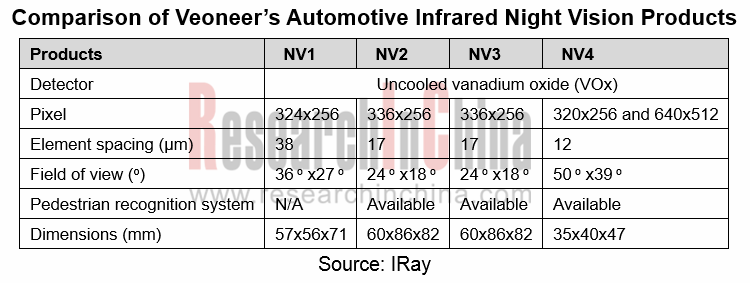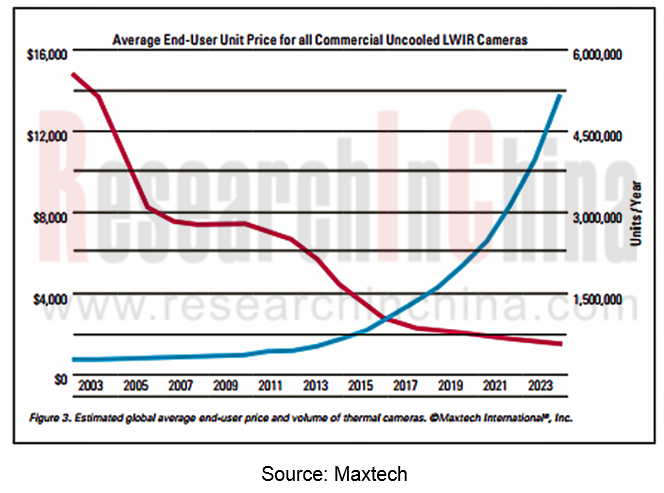Automotive Infrared Night Vision Research: Infrared Thermal Imaging May Handle Extreme Cases Well
Infrared radiation consists of electromagnetic waves in the wavelength region from 0.75 μm to 1,000 μm, lying between visible light and microwave light. The corresponding energy ranges from 0.1eV to 1.0eV, within which all the physicochemical effects can be used for infrared detection. A myriad of detectors have been developed, which can be divided into cooled detectors and uncooled detectors by the operating temperature.
Cadillac equipped its sedans with night vision systems early in 2000, being the world’s first to pioneer such system. Mercedes-Benz, BMW, Audi, etc. followed suit. By 2013, a dozen OEMs had installed night vision systems on their top-of-the-range models but having sold not so well to this day due to the costliness of the night vision system.
4,609 new passenger cars carrying night vision systems were sold in China in 2019, an annualized spurt of 65.6% thanks to the sales growth of Cadillac XT5, Cadillac XT6 and Hongqi H7, according to ResearchInChina.
Now, there is growing concern about safety issues amid strides in ADAS and autonomous vehicle. A controversy arises in the industry particularly after a fatality in Uber's self-driving road test, about whether infrared night vision can be used for autonomous driving to prevent accidents like Uber's incident. Infrared night vision system may be an important option for addressing the safety concern of self-driving in critical situations.
Veoneer is a typical trailblazer that has spawned infrared night vision systems in the world, and its products have experienced four generations. Its 4th-Gen night vision system, expected in June 2020, will have improved field of view and detection distances, reduction in size, weight and cost featuring enhanced algorithms for pedestrian, animal and vehicle detection as well as supporting night time automatic emergency braking (AEB) solutions.
Boson?-based thermal sensing technology from FLIR Systems has been adopted by Veoneer for its L4 autonomous vehicle production contract, planned for 2021 with a “top global automaker”. Veoneer’s system will include multiple thermal sensing cameras that provide both narrow and wide field-of-view capabilities to enhance the safety of self-driving vehicles, and that help detect and classify a broad range of common roadway objects and are especially adept at detecting people and other living things.

Hongqi H7 is provided with an advanced active night vision (ANV) system, which uses the infrared transmitter on the headlights and the camera on the front windshield to simultaneously monitor the area ahead of the vehicle, so that the driver can get clear road conditions at any time.
The near infrared (NIR) night vision system exploited by Hongqi H7 is worth thousands of yuan. Only far infrared thermal imaging technology can see the distance beyond 300 meters.
FLIR has been sparing no effort in the availability of infrared thermal imaging technology in automobiles. In August 2019, FLIR announced its next-generation thermal vision Automotive Development Kit (ADK?) featuring the high-resolution FLIR Boson? thermal camera core with a resolution of 640 × 512 for the development of self-driving cars.
Uncooled infrared imagers and detector technology remain hot in research to date In August 2019, IRay Technology released a 10-μm 1280 × 1024 uncooled infrared focal plane detector. Maxtech predicts that the unit price of uncooled thermal imaging cameras will be below $2,000 after 2021, and the sales will outnumber 3 million units.

Still, infrared cameras are too expensive for automotive use. Israel-based ADASKY, China's Dali Technology, Guide Infrared and North Guangwei Technology are working on the development and mass production of low-cost infrared thermal imagers.
China Automotive Lighting and Ambient Lighting System Research Report, 2025
Automotive Lighting System Research: In 2025H1, Autonomous Driving System (ADS) Marker Lamps Saw an 11-Fold Year-on-Year Growth and the Installation Rate of Automotive LED Lighting Approached 90...
Ecological Domain and Automotive Hardware Expansion Research Report, 2025
ResearchInChina has released the Ecological Domain and Automotive Hardware Expansion Research Report, 2025, which delves into the application of various automotive extended hardware, supplier ecologic...
Automotive Seating Innovation Technology Trend Research Report, 2025
Automotive Seating Research: With Popularization of Comfort Functions, How to Properly "Stack Functions" for Seating?
This report studies the status quo of seating technologies and functions in aspe...
Research Report on Chinese Suppliers’ Overseas Layout of Intelligent Driving, 2025
Research on Overseas Layout of Intelligent Driving: There Are Multiple Challenges in Overseas Layout, and Light-Asset Cooperation with Foreign Suppliers Emerges as the Optimal Solution at Present
20...
High-Voltage Power Supply in New Energy Vehicle (BMS, BDU, Relay, Integrated Battery Box) Research Report, 2025
The high-voltage power supply system is a core component of new energy vehicles. The battery pack serves as the central energy source, with the capacity of power battery affecting the vehicle's range,...
Automotive Radio Frequency System-on-Chip (RF SoC) and Module Research Report, 2025
Automotive RF SoC Research: The Pace of Introducing "Nerve Endings" such as UWB, NTN Satellite Communication, NearLink, and WIFI into Intelligent Vehicles Quickens
RF SoC (Radio Frequency Syst...
Automotive Power Management ICs and Signal Chain Chips Industry Research Report, 2025
Analog chips are used to process continuous analog signals from the natural world, such as light, sound, electricity/magnetism, position/speed/acceleration, and temperature. They are mainly composed o...
Global and China Electronic Rearview Mirror Industry Report, 2025
Based on the installation location, electronic rearview mirrors can be divided into electronic interior rearview mirrors (i.e., streaming media rearview mirrors) and electronic exterior rearview mirro...
Intelligent Cockpit Tier 1 Supplier Research Report, 2025 (Chinese Companies)
Intelligent Cockpit Tier1 Suppliers Research: Emerging AI Cockpit Products Fuel Layout of Full-Scenario Cockpit Ecosystem
This report mainly analyzes the current layout, innovative products, and deve...
Next-generation Central and Zonal Communication Network Topology and Chip Industry Research Report, 2025
The automotive E/E architecture is evolving towards a "central computing + zonal control" architecture, where the central computing platform is responsible for high-computing-power tasks, and zonal co...
Vehicle-road-cloud Integration and C-V2X Industry Research Report, 2025
Vehicle-side C-V2X Application Scenarios: Transition from R16 to R17, Providing a Communication Base for High-level Autonomous Driving, with the C-V2X On-board Explosion Period Approaching
In 2024, t...
Intelligent Cockpit Patent Analysis Report, 2025
Patent Trend: Three Major Directions of Intelligent Cockpits in 2025
This report explores the development trends of cutting-edge intelligent cockpits from the perspective of patents. The research sco...
Smart Car Information Security (Cybersecurity and Data Security) Research Report, 2025
Research on Automotive Information Security: AI Fusion Intelligent Protection and Ecological Collaboration Ensure Cybersecurity and Data Security
At present, what are the security risks faced by inte...
New Energy Vehicle 800-1000V High-Voltage Architecture and Supply Chain Research Report, 2025
Research on 800-1000V Architecture: to be installed in over 7 million vehicles in 2030, marking the arrival of the era of full-domain high voltage and megawatt supercharging.
In 2025, the 800-1000V h...
Foreign Tier 1 ADAS Suppliers Industry Research Report 2025
Research on Overseas Tier 1 ADAS Suppliers: Three Paths for Foreign Enterprises to Transfer to NOA
Foreign Tier 1 ADAS suppliers are obviously lagging behind in the field of NOA.
In 2024, Aptiv (2.6...
VLA Large Model Applications in Automotive and Robotics Research Report, 2025
ResearchInChina releases "VLA Large Model Applications in Automotive and Robotics Research Report, 2025": The report summarizes and analyzes the technical origin, development stages, application cases...
OEMs’ Next-generation In-vehicle Infotainment (IVI) System Trends Report, 2025
ResearchInChina releases the "OEMs’ Next-generation In-vehicle Infotainment (IVI) System Trends Report, 2025", which sorts out iterative development context of mainstream automakers in terms of infota...
Autonomous Driving SoC Research Report, 2025
High-level intelligent driving penetration continues to increase, with large-scale upgrading of intelligent driving SoC in 2025
In 2024, the total sales volume of domestic passenger cars in China was...